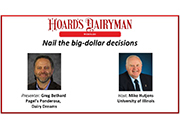 Producing milk is full of peaks and valleys. We love the highs and dread the lows. Understanding your financial status can help your herd maximize profits in good years and mitigate losses the slim years. Greg Bethard, the chief financial officer for two Wisconsin dairies, Pagel's Ponderosa and Dairy Dreams, presented the Hoard's Dairyman webinar and shared his vast experience to guide producers to "Nail the big-dollar decisions."
Producing milk is full of peaks and valleys. We love the highs and dread the lows. Understanding your financial status can help your herd maximize profits in good years and mitigate losses the slim years. Greg Bethard, the chief financial officer for two Wisconsin dairies, Pagel's Ponderosa and Dairy Dreams, presented the Hoard's Dairyman webinar and shared his vast experience to guide producers to "Nail the big-dollar decisions."According to Bethard, an operation should break down each entity to evaluate its profitability separately: the farming or cropping aspect; the replacement costs (both heifer rearing and cow acquisition) and the milk-producing component. One should not subsidize the others. Every dairy operation is different, and producers need to look at their own data and financial status.
"Comparing your operation to the neighbor won't give you any insight into your financial status, unless you have an intimate knowledge of both groups' financials," remarked Bethard. Also, looking just at milk:feed ratios or culling rates don't give the full story.
An extremely high-producing herd does not automatically translate to the most profitable operation. Feed costs are a key component to the efficiencies of converting feed into milk. Income over feed costs (IOFC) is the best number to evaluate; it's a truer picture of your farm's ability to convert feed into milk, Bethard said. Milk efficiency will follow feed efficiency.
Bethard offered these suggestions as keys to making money in the dairy business:
1. Produce lots of milk in a full facility.
2. Have healthy fresh cows.
3. Minimize replacement costs.
4. Capture quality and component premiums.
5. Maximize income over feed costs.
6. Produce high-quality forages.
7. Generate pregnancies (critical for long-term financial success).
8. Cut costs intelligently.
9. Control labor costs per cwt (more milk from the same labor).
10. Minimize shrink.
A profit and loss statement should be done, at a minimum, once a year. If you haven't generated one yet, seek out a consultant, accountant or extension staff who has the expertise to help you.
Learn more about dairy efficiencies, watch the February webinar. It's archived and available for viewing. Past webinars can be found at www.hoards.com/webinars.
Webinars, Economics or Dairy Management follow these links.
 The author is the online media manager and is responsible for the website, webinars and social media. A graduate of Modesto Junior College and Fresno State, she was raised on a California dairy and frequently blogs on youth programs and consumer issues.
The author is the online media manager and is responsible for the website, webinars and social media. A graduate of Modesto Junior College and Fresno State, she was raised on a California dairy and frequently blogs on youth programs and consumer issues.







